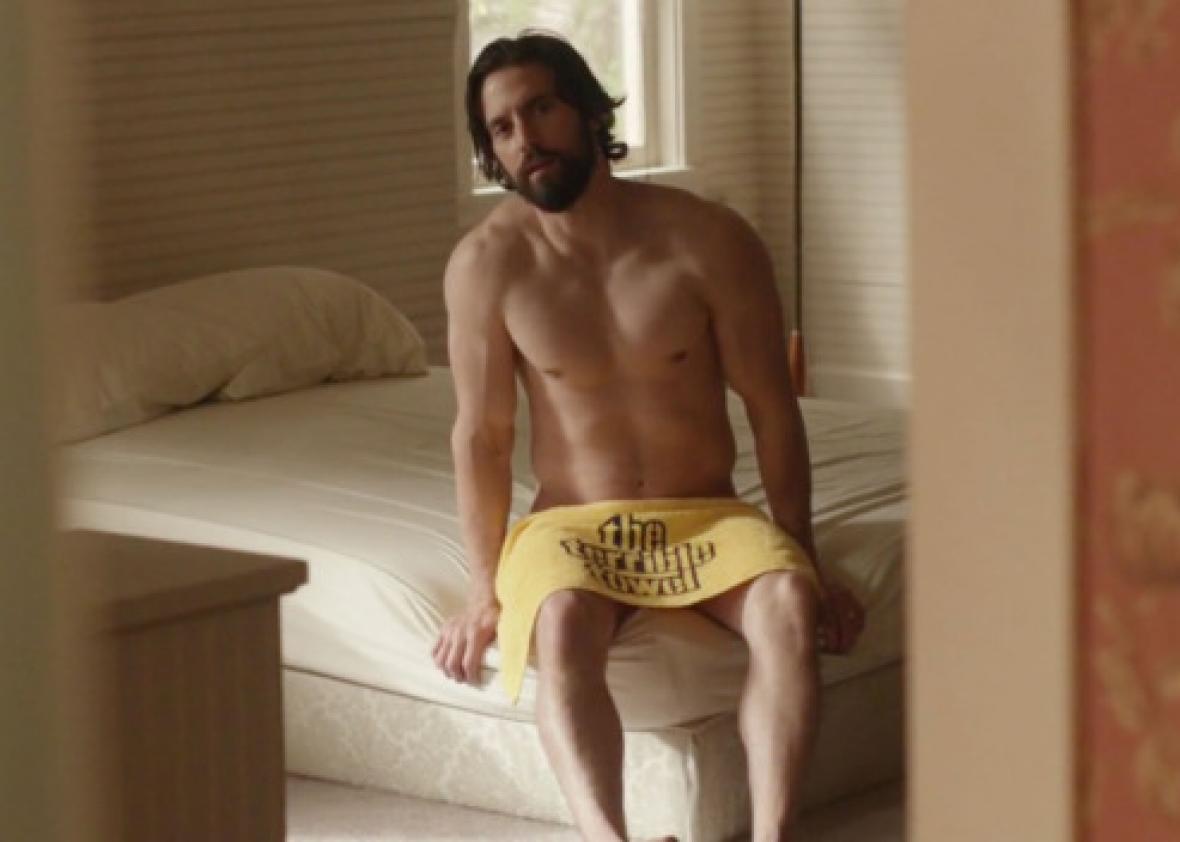This article originally appeared in Vulture.
It’s time for us to discuss a serious issue that plagues our TV screens this fall: Milo Ventimiglia, star of This Is Us, is too buff to play a dad from the 1980s. This makes it hard to watch This Is Us with any sense of seriousness—not, of course, that you’re supposed to watch the show with too much seriousness in the first place.
Let’s take a look at the evidence: Consider the first scene of This Is Us, which seems to take place in 2016, due to the fact that we are witnessing a man, with a body that could be an advertisement for a protein-powder brand, hide his modesty behind a Terrible Towel. As the episode later reveals, this scene takes place in 1980. Mandy Moore and Milo Ventimiglia’s characters are in fact the parents of the other members of the cast. It’s all very surprising and moving and makes you think about the circle of life, etc., but I have one key hang-up: What 1980s workout routine could possibly be responsible for Milo’s body?
See, the ideal male body as we see it today—slim and yet buff in all the right places, the result of dieting, cardio, lifting, bulking, and cutting in all the right proportions—is the product of history. You can chart a transformation across the matinee idols of the decade. Consider the relatively trim Christopher Reeve in 1980’s Superman II or Robert De Niro’s fit (but, in a key delineation, not sculpted) physique in Raging Bull. Later in the decade, Arnold Schwarzenegger and Sylvester Stallone (check out his transformation from Rocky to Rambo) would start to perpetuate a bulkier ideal. If you want to locate a pivotal moment for the place of the male body in the American imagination, you could do worse than looking at the volleyball scene in 1986’s Top Gun, which finds the camera idolizing aspects of the male physique—musculature, especially—in ways that feel familiar to us today, even if the bodies themselves are not yet as scientifically, exaggeratedly toned as the ones we see onscreen today.
This Is Us doesn’t tell us a lot about Jack, Ventimiglia’s character, other than the fact that he rocks a good mustache (aw), he’s a good dad (nice), he’s an alcoholic (sad), and that he loves the Steelers (hey, we all have flaws). As a suburban dad who’s caring for three children in the 1980s, Jack probably doesn’t have time to invest in any newfangled exercise regimens. The best he can hope for is any variety of the leads of Three Men and a Baby, Selleck if he’s lucky. (Not a bad thing!)
Any number of shows feature leads with anachronistic body types. Outlander seems to take place in an 18th-century Scotland with a P90X program; the spies on The Americans could blow their cover at any moment for being just too pretty. But This Is Us seems uniquely intent on marketing itself through its very anachronism. The show’s trailer, which featured Ventimiglia’s butt, got breathless headlines for breaking viewing records on Facebook, and sparked coy comments from the actor himself, who promised the butt might return. Miley Cyrus dunked him with water on Ellen.
In the midst of this, Ventimiglia mentioned that he was trying to maintain a dadbod, and not actually be that perfect. “This was the first time in my career, in 21 years, where the producers said, ‘Stop working out,’ ” he said on The Talk. “They didn’t want me to work out because they wanted to make sure I didn’t look too modern of a man so when the reveal does happen you understand that Rebecca and Jack are from the past and they look of their time.” But in a revealing little contradiction, People interviewed Ventimiglia’s trainer, who dished on the mix of “single leg squats, barbell deadlifts, heavy sled pulls and pushes, and front squats.” You know, dad stuff.
There’s nothing wrong with a little gawking—whatever it takes to make your show survive (and prosper) in the marketplace of peak TV. The odd thing is that, nominally, This Is Us is a drama. It’s about serious issues, like alcoholism, interracial adoption, obesity, and what it means to pursue life as an artist. It’s supposed to make you cry, a lot, with Pavlovian precision.
Milo’s body is just the most obvious example of the suspension of disbelief one must accept to take This Is Us at face value. Sure, life takes us all in strange and unexpected directions, like paint splattered across an abstract painting (this is an actual metaphor from the show). But would the New York theater scene really be so mean to a sitcom actor? Shouldn’t an obese woman think about more than her weight? And could a 1980s father really be that swole? The show gestures toward Big Ideas About Human Experience, but skims over the material and historical context that might give them depth and specificity. I love a good ugly cry as much as the next TV viewer, and I’m not here to insist there be perfect accuracy in every show. But it’s impossible to watch This Is Us and forget you are watching TV, mostly because Milo Ventimiglia is simply too buff to be real.
See also: Mandy Moore on This Is Us, Aging, and Her Character’s Big Secret
